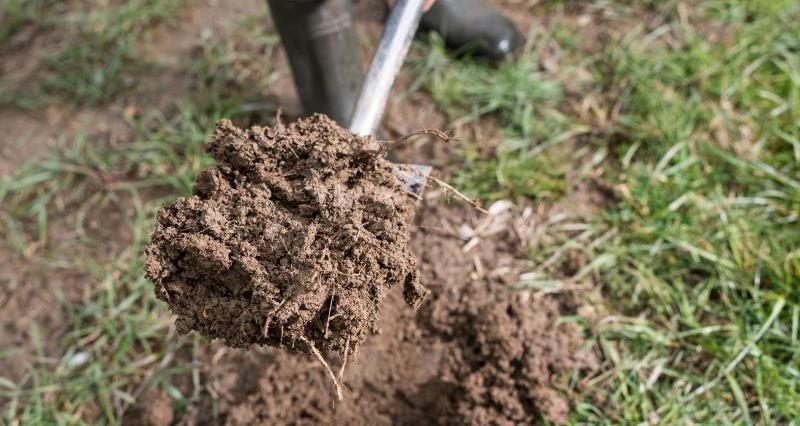Soil can also increase our resilience to climate change, by storing carbon, locking in greenhouse gases that would otherwise be released into the atmosphere, and helping to prevent flooding.
Soil biodiversity
Soil biodiversity is related to the range of living organisms within the soil, including earthworms and the roots of plants, which contribute towards the ecosystem in the soil. Nowhere in nature are species so densely packed as in soil communities. A teaspoon of soil can contain more living organisms than there are people living on earth.
A typical ecosystem in a healthy soil might contain:
- Several species of vertebrates (animals with a backbone)
- Several species of earthworm
- 20-30 species of mites
- 50-100 species of insects
- Tens of species of nematodes (roundworms)
- Hundreds of species of fungi
- Thousands of species of bacteria and actinomycetes (fungi-like bacteria).
Soil is home to a quarter of our planet’s biodiversity. It is one of nature’s most complex ecosystems and one of the most diverse habitats on earth. The wellbeing of all plants and land-based animals depends on the complex processes that take place in soil. It contains a myriad of different organisms, which interact and contribute to the cycles that make all life possible. Soils also play a vital role in storing and purifying water and in mitigating climate change.
Farming and soil - through the seasons
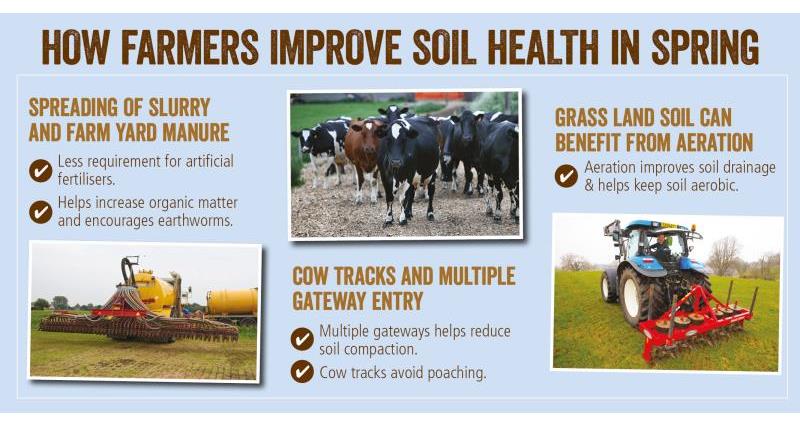
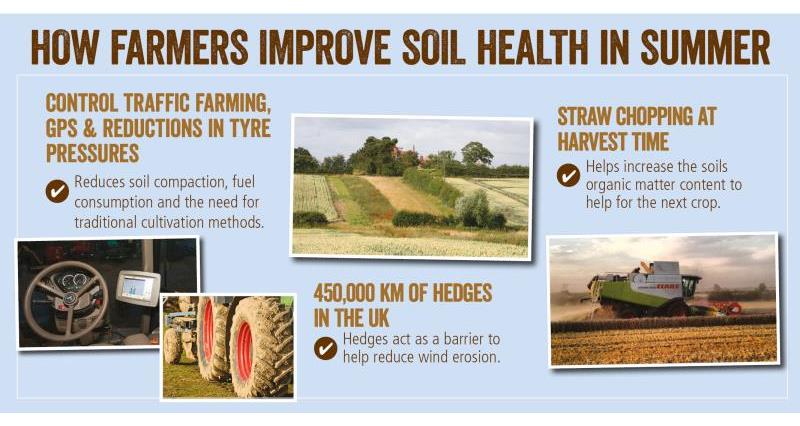
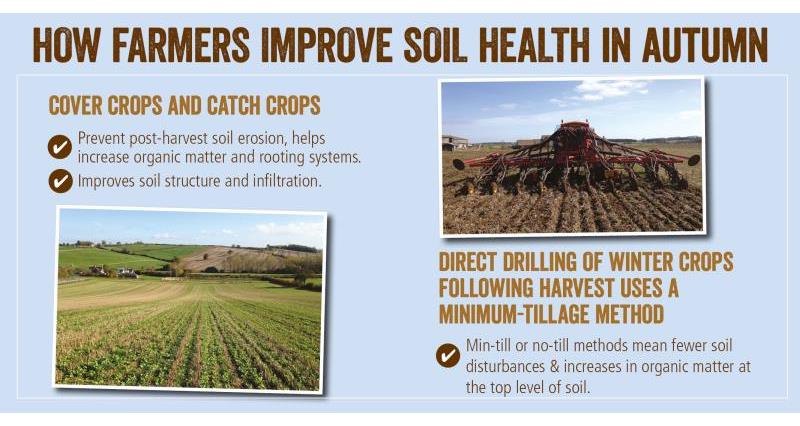
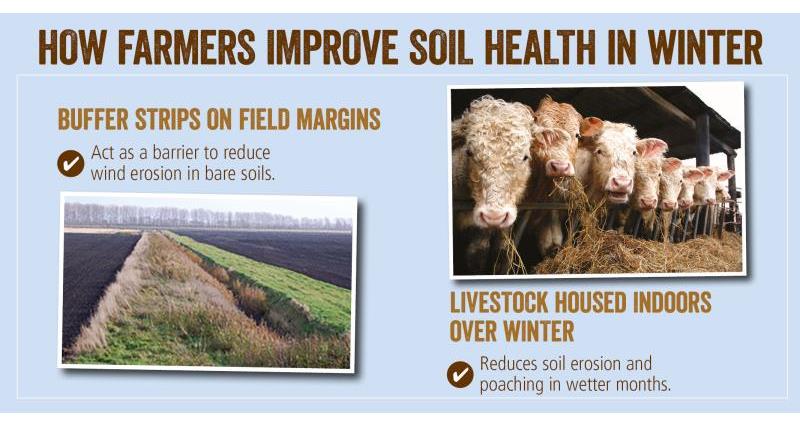
What do farmers do to protect soil quality?
British farmers work hard to protect and maintain healthy soils. Without fertile soils, farmers would not be able to grow crops productively, or support their livestock effectively.
There are more than 700 different types of soil in the UK. The more farmers know about the soils they have on their farm, the better they can make decisions to improve the health of those soils. A 2018 government survey into English farm practices showed that 74% of farmers knew the soil type for each of the fields on their farm and 35% actively tracked the organic matter contained in those soils.
In recent years, new technologies and techniques have been developed that help farmers to look after their soils. Low impact machinery helps to reduce soil compaction, something which can restrict the growth of plant roots and make it more difficult for water to penetrate the soil. Farmers are also using new technology and practices to reduce the amount that soil is disturbed through jobs such as ploughing and planting new seeds.
The Foundation of Food – Our Vision for Good Soil: British Farmers show how they care for soil
In this video farmer David Exwood talks healthy soil:
Farmer Caroline Knox explains why improving soil health makes more food and benefits the environment:
What methods do farmers use to improve soil health?
Throughout the year, farmers do various things to help maintain and improve soil health. This includes practical things such as housing livestock indoors in the winter, or creating multiple gateways into a field, so that the ground is not compacted underfoot or by farm vehicles. Spreading slurry and manure onto fields increases the amount of organic matter returned to the soil and reduces the need to use manufactured fertilisers. Farmers also use more scientific methods, such as sampling soil to monitor the nutrients it contains and adjusting the fertiliser they add to accurately supply the nutrients that are missing.
Key practices used by farmers to improve soil health include:
Cover cropping and crop rotation
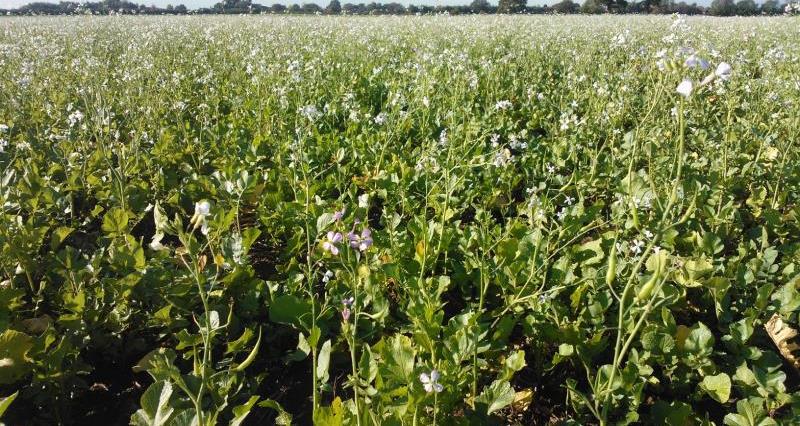
Pictured above: oil radish cover crop
A cover crop is a crop planted primarily to help prevent soil erosion from the weather, improve the structure of the soil, recapture nutrients and increase biodiversity. They tend to be planted in the autumn to protect the soil over the winter months after the main crop has been harvested. Examples of cover crops include brassicas such as mustard, broadleaves such as radish, and legumes (plants with seed pods that split in half) such as clover and vetch which can convert, or ‘fix’, nitrogen from the air into mineral nutrients that will benefit the next crop.
Crop rotation is when different types of crops are grown in succession on the same piece of land so that the soil is not exhausted of any particular set of nutrients. Crops such as legumes are strategically chosen to replenish nutrients that the previous crop may have reduced. Crop rotation also helps to control weeds and reduce crop-specific pest and disease problems.
Voluntary measures
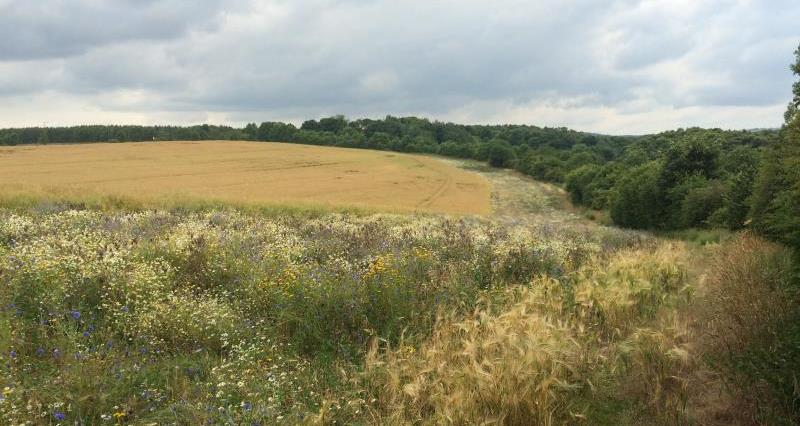
Pictured above: field margins
Farming-industry projects, such as Championing the Farmed Environment (CFE), Tried & Tested and the Voluntary Initiative, have helped farmers to manage their efforts to protect and improve soil health. For example, statistics from 2014 showed that 72,000 hectares of land were put into voluntary soil protection through CFE measures. These include planting buffer strips of grass or other permanent vegetation along the edges of fields to protect against the erosion of topsoil by the natural forces of wind and rain.
Find out more:
Billy Lewis and his parents farm 350 acres at Boycefield farm in Dilwyn, Herefordshire and are passionate about improving their soil health.
The family farm 45 pedigree Hereford suckler cattle and followers, 300 sheep and an area of cereal crops. Around half the farm is made up of permanent pasture, with the other half in what is normally a 6 year cropping rotation. This includes a rotation of winter wheat, winter oats, spring barley and grass which is used for grazing and silaging.
The family has made great strides in their path towards regenerative agriculture by placing a huge emphasis on soil health, which they hope will help to reduce, or even eliminate, the need for artificial fertilisers. They're specifically working towards making their soils biologically active, which means the soil is more productive.
"The driving force behind much of our decision making now takes into account the impact that certain actions may have on the health of our soil."
So, what are the ways they're making that all important soil healthier?
Direct drilling
It's important to have a constant and diverse system of living roots in the ground which feeds the soil and increases organic matter and soil carbon. Soil organic matter improves soil structure, which helps to control soil erosion, improve water infiltration and water holding capacity, which in turn gives plant roots and soil organisms better living conditions
To achieve this, the family plant a catch crop of mustard, buckwheat and phacelia straight after harvesting their winter wheat. Catch crops are a fast-growing crop that can be grown between successive main crops to provide soil cover, organic matter, rooting structure and in certain circumstances provide some livestock grazing.
Winter Oats are then direct drilled into the standing catch crop in October time. Once the oats have been harvested the following summer, they then plant a diverse 8 way cover crop over winter, which is grazed by ewe lambs before being planted with barley in the spring.
They have also experimented with growing cereal crops in a clover living mulch, by direct drilling wheat into existing clover. The clover not only offers a nitrogen source to the wheat but also forms a symbiotic relationship with it, again helping feed soil biology and pump carbon into the ground.

Manure
With livestock comes manure, and with manure comes a great tool to help manage soil health. The family keep manure in a covered muck store over winter, then take it out and place it in windrows (a row of cut hay) in late spring when they begin the composting process.
Keeping the manure in the store over winter prevents any nutrient loss and means it doesn’t become saturated by the rain which causes it to turn anaerobic. Later, when turned into compost, it is full of beneficial microorganisms that support the soil.

Mob grazing
On the livestock side of the business, the family use a mob grazing system for their cattle and sheep. Mob grazing involves moving cattle at least daily between small paddocks, sized to match the number of cattle, and split by portable electric fences. It is beneficial because the grass is allowed to grow longer, before getting eaten down. Once the cattle are moved on to the next patch, the ground has longer to rest. Not only that, but the cattle get to enjoy lush grass.
The effects of mob grazing on the soil and livestock became quickly apparent. The animals are healthy and happy, as they know they’ll be receiving fresh grass every two days.
"You can see the properties of the soil changing in front of your eyes. We’ve found that a truly regenerative farming system cannot be achieved without the incorporation of grazing livestock."
Herbal leys, which are temporary grasslands made up of legumes, herbs and grass species, have allowed the family to grow lots of grass for their animals to graze on and that can be used to produce plenty of silage without any nitrogen fertiliser. The deep rooting nature and nitrogen fixing properties have been a huge benefit to the soil.
While alive and active, roots redistribute carbon and nutrients throughout the soil which benefits soil fertility and carbon storage.

Ultimately in time maintaining a healthy, biologically active soil will help insulate against volatile markets, weather conditions and political demands placed upon farmers heading into the future. Simply tweaking an existing system can give way to a much more exciting and profitable way of farming.
